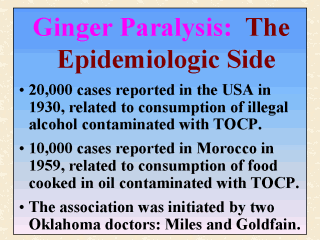| front |1 |2 |3 |4 |5 |6 |7 |8 |9 |10 |11 |12 |13 |14 |15 |16 |17 |18 |19 |20 |21 |review |
 |
Early in 1930,
American newspapers in the south and midwest began to report on a strange new paralytic
illness that eventually had affected some 20,000 people. This first major epidemic was
soon linked to the consumption of Jamaica ginger commonly referred to as “jake” by
those using the fluid extract as an alcohol substitute during the prohibition years. The
association was initiated by two Oklahoma doctors named E. Miles and W.H. Goldfain
(Parascandola, 1994). The alcoholic extracts of Jamaica ginger was not considered as the culprit at the time, because it had been used in the United States since the 19th century, long before the advent of the Prohibition (of the 1930s). Working closely with colleagues in other bureaus and laboratories, Dr. Maurice Smith of the U.S. Public Health Service eventually and shortly confirmed that tri-ortho-cresyl phosphate (TOCP) was the compound responsible for the jake leg syndrome. Because of its relatively low acute toxicity, TOCP almost escaped blame as the poison causing the epidemic. Yet fortunately or unfortunately, TOCP was firmly identified as a constituent of the adulterated jake. And the same delayed paralysis symptoms were seen in rabbits and some other species dosed with a 2.5% solution of TOCP in 80% alcohol (Smith and Elvove, 1930). Another 10,000 people in Morocco were also poisoned with TOCP in 1959. The victims had eaten food cooked in olive oil adulterated with lubricating oil; and the latter happened to be contaminated with TOCP (Manahan, 1989). |